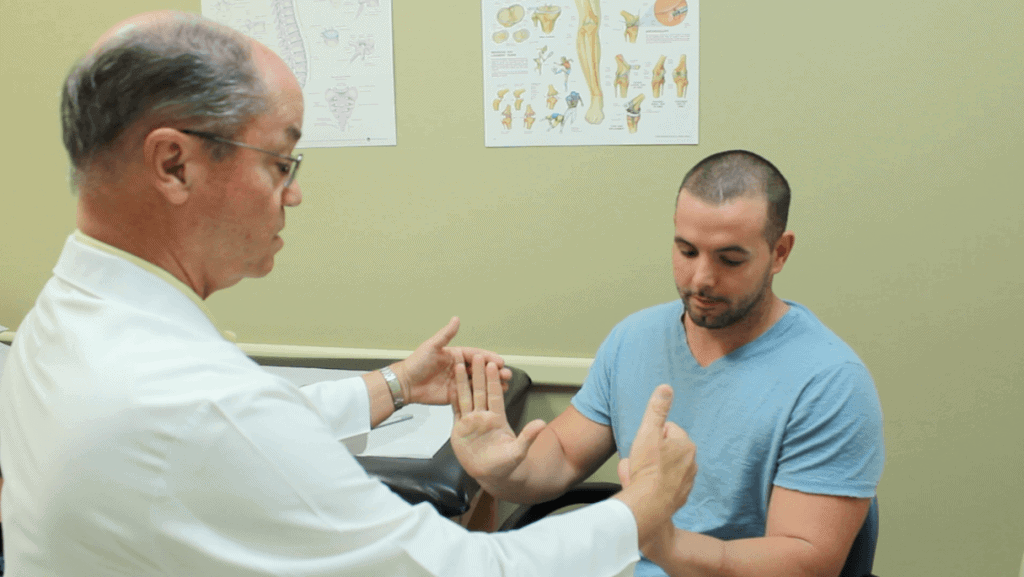Extensor Tendon Repair Surgery Gets Builder Back to Work
- What is Extensor Tendon Repair Surgery?
- How Long Will it Take to Recover from Extensor Tendon Repair Surgery?
- What Are the Results and Outlook of Extensor Tendon Repair Surgery?
When the tendons in our hands or forearms are cut, there is an immediate threat of permanent function loss of the hand. The extensor tendon repair surgery is meant to reconnect the tendons and allow full function to return to the hand – but it takes a skilled, fellowship-trained hand surgeon, a quality team of physical therapists and a bit of time to heal properly and regain strength.
Just ask Jeffery Hicks, a recent patient of Alan W. Christensen, M.D., a board certified orthopaedic surgeon, specializing in hand and upper extremity surgery, at Orlando Orthopaedic Center.
While working with a miter saw at his construction job, Jeffery suffered a deep cut on his left arm, lacerating the extensor tendons in his forearm at the musculotendinous junction. Consequently, he was unable to extend the fingers of his left hand, and feared that he may have lost the use of his hand for good.
“Dr. Christensen took an injury that was almost unfixable and did wonders,” says Jeffery. “I can’t say anything more. I could’ve lost the use of my hand, and now, I have my hand back.”
What is Extensor Tendon Repair Surgery?
The surgical repair procedure involves first making an incision in the forearm and/or hand to determine the proximal and distal ends of the torn or lacerated tendon. The surgeon will then stitch the ends of the tendon back together.
Following tendon repair, the physician will close the wound and apply a soft compressive dressing. In most cases, a solid hand support, known as a splint, is used to hold the hand in place and protect the tendon from overuse and extreme movements during healing. Sometimes, a cast may be used instead of a splint.
Surgical repair of a lacerated or torn extensor tendon requires an experienced hand and specialized equipment. Surgeons, like Dr. Christensen, performing these intricate processes use complex suturing techniques involving ultra-fine materials and surgical loupe magnification.
“Our goal in any extensor tendon repair surgery is to reestablish the integrity and durability of the damaged tendon, thereby renewing as much of previous function as possible,” says Dr. Christensen.
The forearm consists of eight main extensor muscles, which are used to raise the wrist and fingers. These muscles are attached to the arm bones by extensor tendons; cord-like bands made up of tough fibrous connective tissue, located along the forearm that fan out across the back of the wrist and hand.
Extensor tendons are found close to the surface of the skin of the forearm and the hand, making them particularly susceptible to injuries, lacerations, and burns. As extensor tendons are relatively easy to access, the surgical procedure is pretty straightforward. A general or regional anaesthetic is typically used.
How Long Will it Take to Recover from Extensor Tendon Repair Surgery?
 After surgery, the hand may be bruised or swollen, and patients may experience pain after the anaesthetic wears off. Painkillers may be needed for up to 14 days following the operation. The affected tendons will usually remain quite weak until the ends fully heal and join together; a recovery period from one to three months is often necessary. Individual healing times may vary, depending on a range of factors, including the patient’s age, general health and the level of scar formation.
After surgery, the hand may be bruised or swollen, and patients may experience pain after the anaesthetic wears off. Painkillers may be needed for up to 14 days following the operation. The affected tendons will usually remain quite weak until the ends fully heal and join together; a recovery period from one to three months is often necessary. Individual healing times may vary, depending on a range of factors, including the patient’s age, general health and the level of scar formation.
Physicians often stress to their patients that surgery is only the first step toward full recovery. An occupational therapy program, supervised by a professional hand therapist, may be recommended, in order to accelerate the healing process and give the patient the best chance for a complete recovery.
These programs can include exercise, massage therapy, and specialized bandages to control swelling. In order for patients to reclaim the maximum use of their arm and hand, it’s crucial for them to carefully follow their therapist’s instructions and to complete the entire course of therapy. Attempts to use the repaired tendons beyond their capacity during the healing period, can cause them to split apart.
“I underwent [occupational] therapy here at Orlando Orthopaedic as well,” says Jeffery. “The whole staff was great. It’s been a really great experience. Now I have my hand back and can move forward.”
What Are the Results and Outlook of Extensor Tendon Repair Surgery?
If the affected tendon can recover its normal length with sufficient strength, then proper function is achievable. However, fractures, infection, or damage to numerous tendons can make it harder to recover complete finger and hand function. A clean laceration of the tendon often involves a better result than a tendon injury involving crushed or damaged bones and joints.
Your return to work and resuming daily activities depends on the nature of your job, and the site of your injury. Most light activities can usually be resumed after six to eight weeks, and heavier tasks and sports activities after six months. Your surgeon can provide you with a more accurate estimate of your expected recovery period.
“Dr. Christensen was brutally honest,” Jeffery concludes. “He didn’t sugarcoat anything, and he’s going to explain everything to you, every possible scenario along the way. He was able to work wonders, and now I’m able to close my hand completely. He’s professional and he’s very, very good.”



